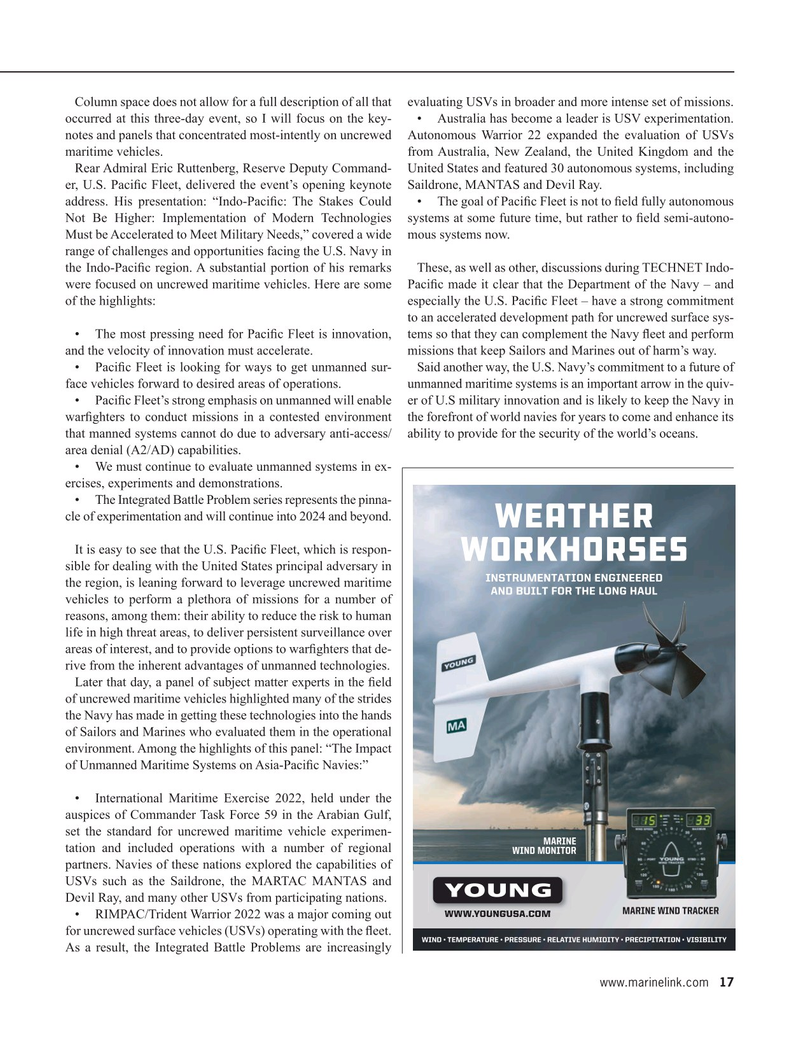
Page 17: of Maritime Reporter Magazine (January 2024)
Read this page in Pdf, Flash or Html5 edition of January 2024 Maritime Reporter Magazine
Column space does not allow for a full description of all that evaluating USVs in broader and more intense set of missions. occurred at this three-day event, so I will focus on the key- • Australia has become a leader is USV experimentation. notes and panels that concentrated most-intently on uncrewed Autonomous Warrior 22 expanded the evaluation of USVs maritime vehicles. from Australia, New Zealand, the United Kingdom and the
Rear Admiral Eric Ruttenberg, Reserve Deputy Command- United States and featured 30 autonomous systems, including er, U.S. Paci? c Fleet, delivered the event’s opening keynote Saildrone, MANTAS and Devil Ray. address. His presentation: “Indo-Paci? c: The Stakes Could • The goal of Paci? c Fleet is not to ? eld fully autonomous
Not Be Higher: Implementation of Modern Technologies systems at some future time, but rather to ? eld semi-autono-
Must be Accelerated to Meet Military Needs,” covered a wide mous systems now.
range of challenges and opportunities facing the U.S. Navy in the Indo-Paci? c region. A substantial portion of his remarks These, as well as other, discussions during TECHNET Indo- were focused on uncrewed maritime vehicles. Here are some Paci? c made it clear that the Department of the Navy – and of the highlights: especially the U.S. Paci? c Fleet – have a strong commitment to an accelerated development path for uncrewed surface sys- • The most pressing need for Paci? c Fleet is innovation, tems so that they can complement the Navy ? eet and perform and the velocity of innovation must accelerate. missions that keep Sailors and Marines out of harm’s way. • Paci? c Fleet is looking for ways to get unmanned sur- Said another way, the U.S. Navy’s commitment to a future of face vehicles forward to desired areas of operations. unmanned maritime systems is an important arrow in the quiv- • Paci? c Fleet’s strong emphasis on unmanned will enable er of U.S military innovation and is likely to keep the Navy in war? ghters to conduct missions in a contested environment the forefront of world navies for years to come and enhance its that manned systems cannot do due to adversary anti-access/ ability to provide for the security of the world’s oceans.
area denial (A2/AD) capabilities.
• We must continue to evaluate unmanned systems in ex- ercises, experiments and demonstrations.
• The Integrated Battle Problem series represents the pinna- cle of experimentation and will continue into 2024 and beyond.
It is easy to see that the U.S. Paci? c Fleet, which is respon- sible for dealing with the United States principal adversary in the region, is leaning forward to leverage uncrewed maritime vehicles to perform a plethora of missions for a number of reasons, among them: their ability to reduce the risk to human life in high threat areas, to deliver persistent surveillance over areas of interest, and to provide options to war? ghters that de- rive from the inherent advantages of unmanned technologies.
Later that day, a panel of subject matter experts in the ? eld of uncrewed maritime vehicles highlighted many of the strides the Navy has made in getting these technologies into the hands of Sailors and Marines who evaluated them in the operational environment. Among the highlights of this panel: “The Impact of Unmanned Maritime Systems on Asia-Paci? c Navies:” • International Maritime Exercise 2022, held under the auspices of Commander Task Force 59 in the Arabian Gulf, set the standard for uncrewed maritime vehicle experimen- tation and included operations with a number of regional partners. Navies of these nations explored the capabilities of
USVs such as the Saildrone, the MARTAC MANTAS and
Devil Ray, and many other USVs from participating nations. • RIMPAC/Trident Warrior 2022 was a major coming out for uncrewed surface vehicles (USVs) operating with the ? eet.
As a result, the Integrated Battle Problems are increasingly www.marinelink.com 17
MR #1 (1-17)_2.indd 17 1/9/2024 11:51:30 AM

 16
16

 18
18
